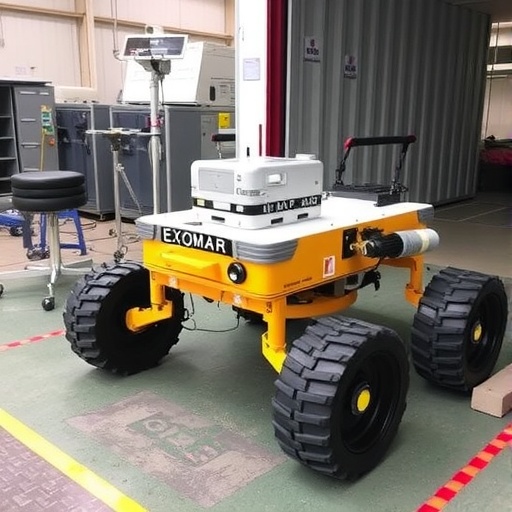The quest to answer one of humanity’s most profound questions—are we alone in the universe?—is experiencing a significant advancement with the shipping of a cutting-edge instrument from Aberystwyth University to Italy for crucial testing and integration into a mission poised to explore the Martian surface. This instrument, known as Enfys, is an infrared spectrometer that will play an integral role in the upcoming ExoMars mission, specifically the Rosalind Franklin Rover, which is set to embark on a journey to the red planet to search for signs of life, both past and present.
As part of the European Space Agency’s ambitious ExoMars program, the Rosalind Franklin Rover is Europe’s first rover dedicated to Martian exploration. Unlike its predecessors, the rover is equipped with advanced technologies that enable it to drill deep beneath the Martian surface, reaching depths of up to two meters. This capability is crucial as it allows scientists to analyze subsurface materials that may contain organic compounds and potential biomarkers, providing valuable evidence in the search for life. This mission represents a significant leap forward in planetary exploration, engaging some of the brightest minds in the field of astrophysics and planetary science.
Enfys is designed to work in concert with the PanCam system, a panoramic camera operated by the Mullard Space Science Laboratory at University College London. This collaboration is aimed at identifying mineral targets on Mars that may hold clues about the planet’s geology and the historical conditions that may have allowed life to flourish. With this investigative tandem, the rover will select optimal drilling sites that enhance the probability of discovering signs of ancient life, while other onboard instruments will carry out detailed analyses of the gathered samples.
The instrument now making its way to Italy will be installed on the Ground Test Model of the rover, a replica designed to simulate real Martian conditions. The Aerospace Logistics Technology Engineering Company in Turin houses this model, which is crucial for testing and refining the rover’s systems prior to its final launch. The simulations take place in a Mars terrain simulator, providing scientists the opportunity to investigate various operational scenarios, ensuring that the mission is prepared for any challenges it might encounter upon reaching Mars.
Dr. Matt Gunn, a key figure in this project from the Department of Physics at Aberystwyth University, has expressed the significance of this developmental milestone. He noted that the preparation of Enfys marks a proud achievement for Welsh science, placing Aberystwyth University at the forefront of this monumental planetary exploration initiative. As Principal Investigator on the Enfys project, he emphasized the arduous efforts put forth by the team, drawing upon years of experience in developing space instrumentation. Successfully shipping Enfys for testing is a testament to their dedication and expertise, establishing a robust foundation for the work that lies ahead.
With the Rosalind Franklin Rover poised to pioneer drilling technology on Mars, the scientific community is abuzz with anticipation. Dr. Helen Miles, who serves as the Operations Software Lead for Enfys, highlighted the rover’s unprecedented ability to drill into Mars’ sub-surface layers. This exploration is particularly thrilling, as it may reveal preserved evidence of biological activity or even remnants of microbial life that existed millions of years ago. Dr. Miles conveyed her excitement and pride in being part of a mission that could unlock profound secrets about the origins of life beyond Earth.
In light of recent events, Aberystwyth University’s growing responsibility within the mission has increased, stemming from the shift in international collaboration dynamics, particularly following the cessation of partnerships with Russia’s Roscosmos due to geopolitical tensions stemming from the invasion of Ukraine in 2022. This has positioned the university’s scientists to take a leading role, allowing them to drive the development and testing of Enfys forward without external constraints.
The journey of Enfys represents just the beginning of a series of milestones for the Aberystwyth-led team as they prepare for the next stage: the construction of the flight model of the instrument. This flight model will be outfitted onto the Rosalind Franklin Rover in the final steps before its launch to Mars, making the seamless integration of cutting-edge technology and careful planning essential.
Support for the development of Enfys has come considerably from the UK Space Agency, which has committed an additional £10.7 million towards its creation. This financial backing underlines the importance of the mission, not only as a scientific endeavor but also as a beacon of technological advancement for the future of space exploration. The funding allows researchers to focus on achieving groundbreaking scientific objectives and ensuring mission success.
A multifaceted approach characterizes the ExoMars mission, where the collaboration extends beyond Aberystwyth University to include various esteemed partners within the scientific community. The combined expertise from institutions such as the Mullard Space Science Laboratory at UCL, STFC Rutherford Appleton Laboratory, and Qioptiq Ltd. forms the backbone of this ambitious project. Each partner plays a critical role in shaping the mission’s trajectory, fostering innovations that drive advancements in space science.
In conclusion, the journey of Enfys from Aberystwyth University to Italy epitomizes not just a physical relocation of a scientific instrument, but a pivotal moment in the quest to understand life beyond Earth. The ExoMars Rosalind Franklin Rover, equipped with innovative technologies, promises to explore uncharted territories on Mars, potentially unveiling the secrets held beneath its harsh surface. As anticipation builds over what discoveries await, the scientific community remains hopeful that this ambitious mission will shed light on our place in the cosmos and perhaps reveal that we are not alone in this vast universe.
Subject of Research: Development of Enfys and its role in the ExoMars Mission
Article Title: Advancing the Search for Life on Mars: Enfys’s Journey to Testing
News Publication Date: [Insert Date]
Web References: [Insert Links]
References: [Insert References]
Image Credits: Aberystwyth University
Keywords
Space sciences, Space exploration, Mars rovers, Research universities, Technology, Computer science




